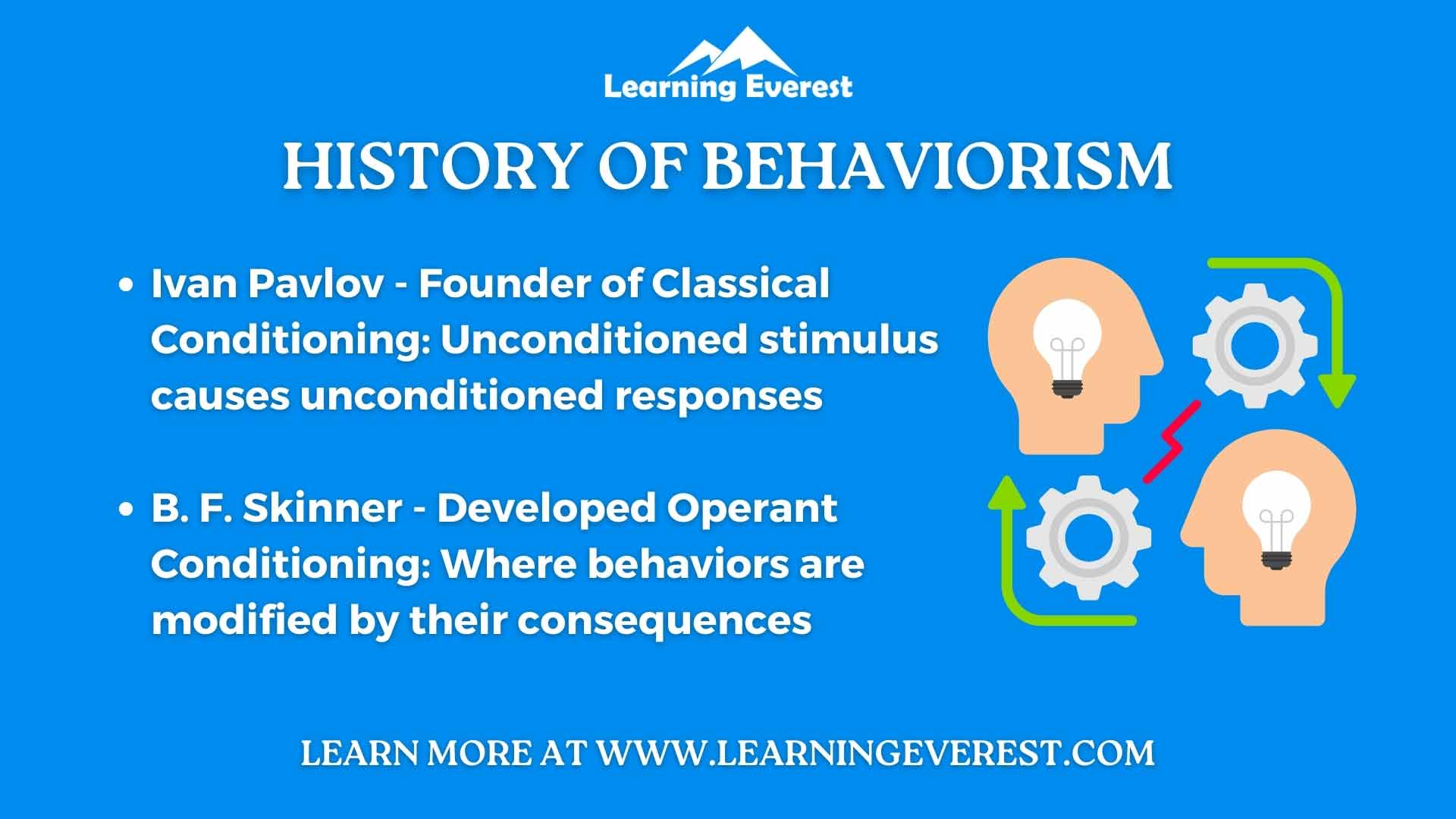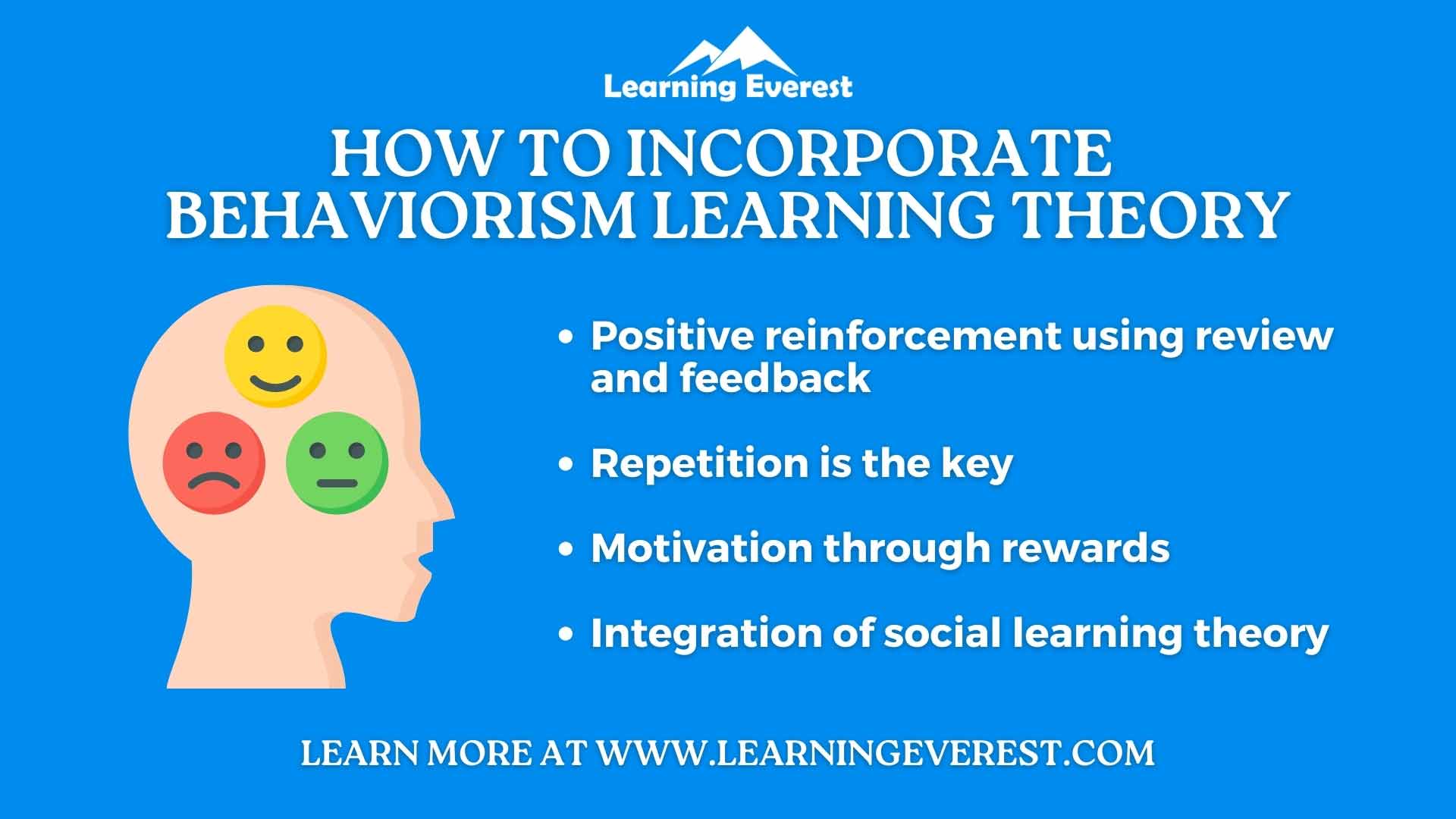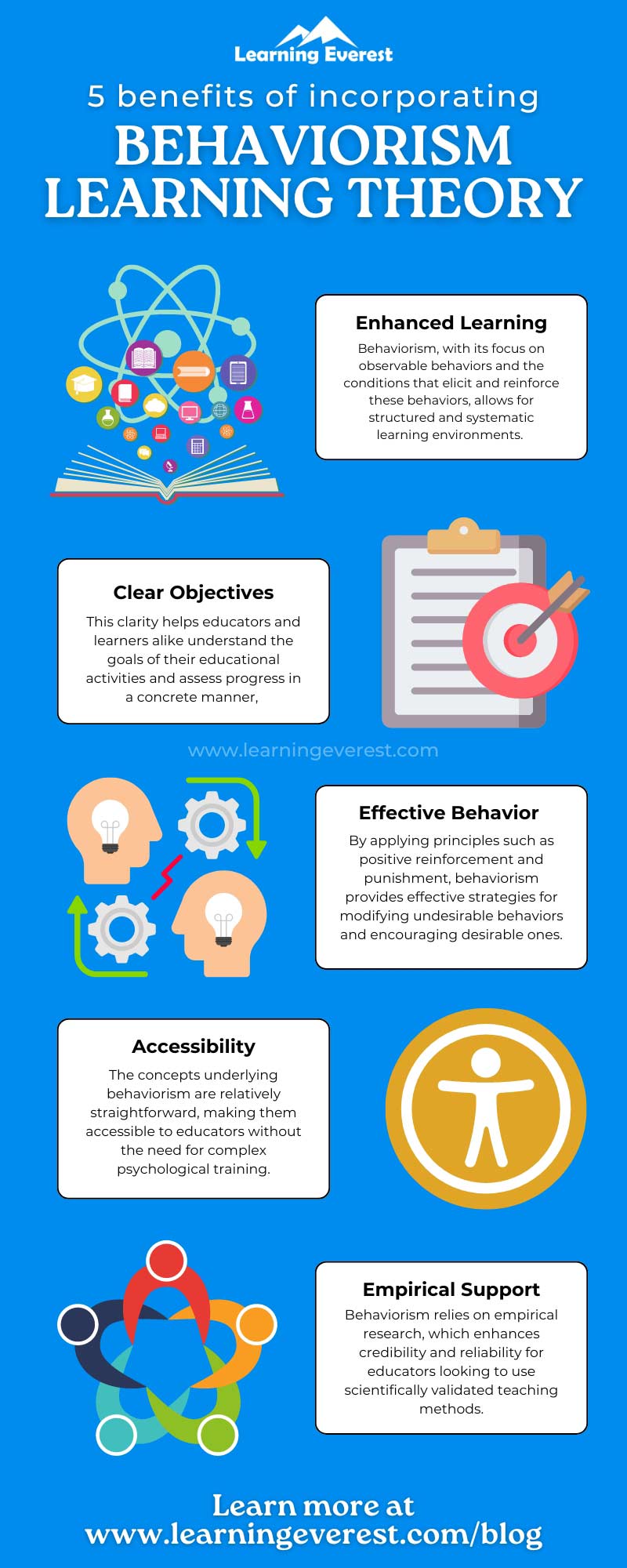Behaviorism as a theory that has practical applications in our daily lives. There are three approaches within behaviorism learning theory– classical conditioning, operant conditioning, and observational learning. All these methods involve the process of conditioning, whereby a person or an animal learns to connect a particular stimulus with a particular response.
Table of Contents
Here we will discover these approaches and explore if we can incorporate practical implications of them into corporate L&D programs. Let’s begin!
First and foremost…
What is the history behind behaviorism
Psychology, as we know it today, has its roots in behaviorism. It is a theory that began with the groundbreaking work of Ivan Pavlov. Pavlov found classical conditioning, and B. F. Skinner discovered operant conditioning. Behaviorism learning theory is based on the idea that environmental factors define our behavior, not our internal cognitive states. This means that all behavior can be defined by how we have been conditioned to respond to our surroundings.

History of Behaviorism
Behaviorism has not only shaped the field of psychology but also our understanding of human behavior. However, it has also faced criticism for its lack of focus on cognitive states and its emphasis on external aspects as the cause of all behavior.
Classical conditioning
Classical conditioning, also known as Pavlovian conditioning. It is a learning process originally detailed by Ivan Pavlov. It’s a method where a natural reflex gets linked to a new, initially neutral, trigger. Pavlov demonstrated this with an experiment involving dog and a bell. At first, the dogs didn’t react to the bell, but after repeatedly hearing the bell before being fed, they started to salivate just from the sound of the bell, even without food present. In this scenario,
- The food represents the unconditioned stimulus, which naturally elicits a response—salivation, the unconditioned response.
- The bell, which initially had no effect, became the conditioned stimulus after the association was learned, and
- The salivation in response to the bell alone became the conditioned response.
Operant conditioning
Operant conditioning, also known as Skinnerian conditioning or instrumental conditioning, is a development process where behaviors are modified by their consequences. This method of learning involves rewards and punishments to encourage or discourage behaviors.
The four types of it:
1 – Positive reinforcement
Positive reinforcement refers to introducing a desirable stimulus after a behavior. The desirable stimulus reinforces the predefined behavior, making it more likely to reoccur. For example, a manager might offer a bonus or a public commendation to an employee who completes a project ahead of schedule. This positive reinforcement can motivate the employee and others to maintain high performance.
2 – Negative reinforcement
Negative reinforcement encourages certain behaviors by eliminating or avoiding a negative outcome or stimuli. People typically use this approach to help learn good patterns of behavior. Consider a scenario where an employee can leave work early once they complete all their tasks for the day. The removal of the less desirable condition (staying at work for the full day) reinforces the behavior of completing tasks efficiently.
3 – Positive punishment
Positive punishment involves adding an aversive stimulus after an unwanted behavior to discourage a person from repeating the behavior. For instance, If an employee consistently arrives late to work, a manager might implement a policy where repeated tardiness leads to a deduction in their annual leave balance.
4 – Negative punishment
In negative punishment, you remove a pleasant stimulus to decrease a behavior. For example, if a participant frequently uses their phone during a training session, the facilitator might decide to restrict their access to the training materials online. In this case, a stimulus is removed to decrease the behavior.
B.F. Skinner developed this concept, which is fundamental to behavioral psychology. It’s used in various settings, including education, therapy, and animal training.
Observational learning
Observational learning is another development process where individuals learn by monitoring the actions of others and then imitating those behaviors. The concept is closely associated with psychologist Albert Bandura, who is renowned for his work in this field. Through observational learning, people can acquire new behaviors without direct experience.
Bandura’s famous Bobo doll experiment showcased this phenomenon. In the experiment, children watched a video of an adult behaving aggressively toward a Bobo doll, a type of inflatable toy. Later, when given the chance to interact with the doll themselves, the children who had observed the adult facing no repercussions—or even being rewarded—for their aggression were more likely to act similarly. On the other hand, children who saw the adult being punished were less inclined to replicate the aggressive behavior. This experiment highlighted the significant role of observed consequences in shaping a child’s likelihood to imitate actions.
Incorporating Behaviorism learning theory in L&D programs
In the L&D, the behavioral learning theory is key to understanding how to motivate and help learners. Information is transferred from instructors to learners from a response to the right stimulus. Learners are passive participants in behaviorism learning— instructors are giving them the information as an element of stimulus-response. Instructors use behaviorism to show learners how to react and respond to certain stimuli. This needs to be done repetitively to regularly remind them what behavior is being looked for. Teachers can implement behaviorism learning strategy techniques in their classroom in many ways, including:

How to incorporate Behaviorism learning theory
Let’s discuss.
1) Positive reinforcement using review
Positive reinforcement is key in behavioral learning theory. Without it, learners will quickly abandon their responses because they don’t appear to be working. Reviews are also important to behavioral learning theory. Going back over the material and giving positive reinforcement will help learners retain information much better. The program can use positive reinforcement to encourage continued engagement and improvement; for example, trainers can provide immediate feedback and praise to participants who demonstrate improvement or mastery of their skills.
Moreover, the organization can introduce a leaderboard that tracks progress, and top performers receive recognition during company meetings. Participants who excel in the training program are given opportunities for real-world application. By incorporating these strategies, the training program teaches the desired behaviors and motivates adult learners to continue applying what they’ve learned.
2) Repetition is the key
Repetition and positive reinforcement go hand in hand with the behaviorism learning theory. Educators often work to strike the right balance between repeating the situation and having positive reinforcement come to show learners why they should continue that behavior. Behaviorist classrooms utilize positive reinforcement regularly. This can be in the form of verbal reinforcement and praise, reward systems, added privileges, and more. The training might include several repetitive elements to reinforce learning, such as role-playing scenarios where participants repeatedly practice desired behaviors, weekly workshops to review key negotiation tactics, e-learning modules that participants can revisit to reinforce their knowledge, etc.
3) Motivation through rewards
Motivation plays an important role in behaviorism learning. Positive and negative reinforcement can be motivators for learners. Imagine an L&D program designed to improve customer service skills. The program includes a series of interactive modules that teach various aspects of customer interaction. To motivate participants, the program could offer digital badges for each module completed. Additionally, those who complete all modules with high scores might receive a certificate of excellence. This type of recognition serves as positive reinforcement, encouraging learners to continue engaging with the program and strive for high performance.
4) Integration of social learning theory
Social learning theory agrees with behaviorism learning theory, which is about outside influences on behavior. However, the social learning theory goes further and suggests that internal psychological processes influence behavior. Behavioral learning theory might be applied through role-playing exercises where participants practice negotiation skills. They receive immediate feedback from peers and trainers, which serves as external reinforcement to modify behavior. The program could include a mentorship component where less experienced leaders observe and interact with seasoned executives. This allows them to witness successful behaviors in real-world contexts and understand the internal thought processes behind these actions through discussions and Q&A sessions.
What else would you like to add?
Learn more about how we can help you build a custom plan to upskill your employees through our personalized online employee training programs.
Infographic
Knowledge Check!
Frequently Asked Questions (FAQs)
Q: Who is the father of behaviorism learning theory?
A: Behaviorism learning theory began with the groundbreaking work of Ivan Pavlov, who found classical conditioning, and B. F. Skinner, who discovered operant conditioning.
Q: What is observational learning?
A: Observational learning is another development process where individuals learn by monitoring the actions of others and then imitating those behaviors.
Q: What is positive reinforcement?
A: Positive reinforcement refers to introducing a desirable stimulus after a behavior. The desirable stimulus reinforces the predefined behavior, making it more likely to reoccur.






